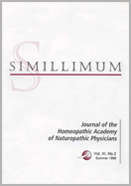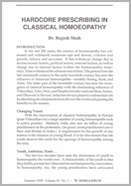Hardcore prescribing in Classical Homeopathy
In the last 200 years, the science of homeopathy has witnessed and withstood numerous ups and downs, criticism and growth, failures and successes.

"Hardcore prescribing in Classical Homeopathy"
by Dr. Rajesh Shah, M.D.
Simillimum - Journal of Homeopathic Academy of Naturopathic Physicians, USA. Vol.XI, No.2 Summer '98"
Introduction:
In the last 200 years, the science of homeopathy has witnessed and withstood numerous ups and downs, criticism and growth, failures and successes. It has withstood change due to socio economic factors, political factors, external factors, as well as change due to internal (within the homeopathic fraternity) factors. It has withstood the ultimate test of time. The period from the late nineteenth century to the early twentieth century has seen the influence of American homeopaths notably Hering, Kent, and Allen.The latter part of the twentieth century has seen the resurgence of classical homeopathy with the dominating influence of Vithoulkas, Tyler, Weir and Shepherd in the west and Bose, Sarkar and Dhawale in the east. India has always played a substantial role by absorbing developments from all over the world and passing the benefits to the masses.
Changing Trend:
With the rejuvenation of classical homeopathy in Europe (Post Vithoulkas), a large number of young homeopaths took to active practice. Similarly India also saw an influx of young practitioners in the profession. (As proof, most practitioners are in their mid-thirties in India). A requirement for the growth of any science is the infusion of young blood. It is for this reason that the youth deserve the credit for the upsurge of homeopathy among the laity.
Youth, ambition, haste...
The last two decades have seen the dominance of youth in homeopathy the world over. A characteristic of the youth is that they boldly pursue new ideas and are not hampered by convention. In homeopathy, too, the young practitioners have advocated several new or even radical approaches. Some of these approaches, particularly those related to case analysis; have been widely accepted by the fraternity. This acceptance has spurred some homeopaths into adopting new untried (inadequately experimented) techniques in a hasty manner.
From Innovation to Speculation:
Some of the radical approaches that have been too hastily adopted, have created confusion in the fraternity. This is because these techniques are not as successful as their propagators claim. For example, dream analysis. According to this new approach the patients' dreams have to be evaluated to get a feel of the patient and thereby selecting a remedy that will fit the Simillimum. The traditional approach is to select the remedy under a particular dream or to select a remedy which causes the dream. The new approach rejects the traditional approach and says that each dream has to be evaluated for its significance and based on this a remedy should be proposed. Now a dream is highly subjective and each dream can be interpreted in 10 different ways by 10 different practitioners. This approach has crossed the boundary from innovation to, speculation. An examination of any scientific journal will show that a lot of homeopathic case studies involve speculation. The scientific foundations of homeopathy are in danger of being corroded by speculation.
Any science is founded on bedrock theories. All theories start as speculation. The speculation is subjected to experimentation, criticism, alteration and even outright rejection. It is only when the speculation has stood the test of time, it is accepted as a theory.

Time to come-back:
The end of the second century requires that the homeopathic community be alert and go back to its roots. The basis of prescription, as Hahnemann propounded, should be only drug proving: the simple matching of the patient's history and symptoms, to the drug proving data. Innovation and imagination are very much needed for progress but they should not result in the scrapping of reality.
Hard core prescription
What is hard core prescription? It is nothing but prescription based on hard facts. This is not a new theory. An examination of case studies in journals will show that, in many case studies, the prescription is based on a totality interpretation.The "Totality" is often based on an abstract interpretation of the patient's dreams, symbols, illusions, etc. The case prescription is based on interpretation, which makes for a very soft and flexible core. This is because different practitioners can interpret the case in different ways and thereby propose different prescriptions.
In hard-core prescribing, the core of the case is hard and rigid. Most importantly, the core of the case is not subject to loose interpretation. The core consists of well-defined facts such as patient's dreams, thermal states, mental state, modalities, concomitants, dislikes, pathology, sleep pattern, etc. These are hard data and are not subject to misinterpretation. The patient's symptomatology should match with the drug proving data. The advantage with the hard-core approach is that no part of the case handling is subject to the practitioner's subjective interpretation or imagination. Whoever the practitioner may be. The hard core of the case will allow all practitioners to reach the same prescription.
Here are some case illustrations of hard-core prescriptions:
Case one:
Mrs. K. S., a 75-year-old lady, was bedridden for 5 months. She had an open wound (6 inches long, 2-1/2 inches wide, and 2 to 3 inches deep) on the left gluteal region. This wound was a result of hip-joint surgery (for fracture of the head of the femur. Since the lady was a diabetic, the wound refused to heal in spite of two surgeries. The patient had chronic suppuration of the wound and profuse pustular discharge requiring daily cleaning and dressing, under the supervision of an orthopedic physician. She had febrile episodes every week (more at night) along with frequent urinary tract infection. Her urine samples showed more than 400 pus cells in each report. The failure of higher generation drugs had made the patient turn to homeopathy even though her family and the orthopedic practitioner were skeptical of the chances of recovery. The homeopath carefully studied patient and made video recordings
Life-space study
The old lady was the second wife of a rich industrialist who had expired about ten years back. He had four sons and a well-established family business. The lady was strong-willed and had seen many ups and downs. Now she was seeing the sons gamble away all their father's riches. From living like a queen, the lady was forced to live with a stepdaughter in a lower middle class house.
Totality
- Non-healing abscess
- Suppuration, chronic infection
- Diabetes, disposition
- Nightly fever
- Frequent urinary tract infection
- Sweat, offensive and staining
- Dreams of robbers, falling, fire, anger
- Strong will, obstinacy, despair
- Thermal factors: sensitive to heat and cold
- Desire: milk, sweets, bread, salt
- Weeping, mild, anxious

These hard-core facts are solid indicators. Solid indicators are those that will be accepted by any homeopath without any controversy.
Treatment and response:
The lady was prescribed Mercurius solubilis in 200C potency, to be taken twice a day for 6 weeks and then in 1M potency, twice a day for another 6 weeks.
In the first 6 weeks, the purulent discharge reduced considerably and the febrile episodes reduced to twice in 6 weeks. She had an acute urinary infection, for which she was prescribed some doses of Cantharis 30. The subsequent urinary reports were clear.
At the end of 4 months, the patient had fully recovered and was mobile. For the skeptical doctor and family, this was a revelation.
lass="artbold">Case two:
13-year-old Monti R., from a lower middle class Punjabi family, was brought on October 24, 1994, for the treatment of mal-absorption syndrome. He had this since he was 5 or 6 years old. The boy had frequent stools (10 to 15 per day), semi-solid to watery, which were offensive with flatus, painless, and without mucus, blood, or worms. He would defecate after every meal or drink, however small. He failed to put on weight and was a constant 33 kilograms for two years. Other symptoms Increased appetite and thirst, with no marked likes and dislikes for food. Ambithermal, with warm palms. Profuse sweating, non-staining. Slept well on his back, with no significant dreams.
Mental state:
Poor at studies, irritated at trifles, very timid, fearful, obstinate, self-willed, and hot-tempered. Mischievous, When angry, he would beat his brother and sister. Got beaten by young children while playing. Wept easily when scolded by mother or teacher. Could not answer in class. Fond of spending money on kites balls, bat, etc.
TOTALITY
Anger, beating
Timidity, cowardice
Weeping, shy
Poor at studies, memory, concentration
Increased appetite, thirst, sweat
Mal-absorption-bowel disorder
Lean, thin, ill-nourished
Stool: frequent, semi-solid, after eating and drinking.
Treatment and follow up:
The hard data suggested his constitutional remedy to be Lycopodium, which was administered in 200 potency, a single dose on October 27, 1994.
A month later:
His bowel frequency gradually reduced from 10 to 15 times per day to twice a day, and the stool was well-formed. His excessive appetite was reduced to normal. His frequent headaches stopped. He put on one kilogram of weight.
Follow-up after 10 months:
He was reported to be having no gastro-intestinal ailment for the last 6 months. He maintained good health, and his body weight was 37 kilograms. His treatment was terminated.
Summary:
Hard Core prescription is the need of the hour, in order to;
- Expect consistent results
- Instill confidence in the young homeopathic generation
- Prove and maintain the scientific integrity of the fundamental principle of homeopathy
- Make homeopathy practicable by every average practitioner
- Generate mass public acceptance of homeopathy
[This article was originally published in The Homeopath, UK] Rajesh Shah has studied homeopathy intensively for 18 years, and has lectured in the international circuit for eight. He is founder and director of The Foundation for Homeopathic Research in Bombay, teaches at CMP Homeopathic Medical College and Hospital, and is editor of Homeopathy Times. His book My Experiences with Ferrrum metallicum was published in 1992. Dr. Shah conducts an intensive clinical training course, for European and American homeopaths, in Bombay, every year.